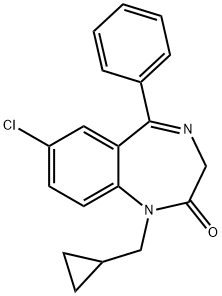Manufacturing Process
Preparation of 2-Cyclopropylcarbonylamido-5-Chlorobenzophenone: To 400.5 g (1.73 mols) of 2-amino-5-chlorobenzophenone dissolved in 220 g (2.18 mols) of triethylamine and 3.5 liters of tetrahydrofuran is added cautiously 181 g (1.73 mols) of cyclopropanecarboxylic acid chloride. The reaction is refluxed 2? hours and allowed to cool to room temperature. The solvent is then removed under vacuum to obtain 2-cyclopropylcarbonylamido-5chlorobenzophenone as a residue which is dissolved in 1 liter of methylene chloride, washed twice with 5% hydrochloric acid, and then twice with 10% potassium hydroxide. The methylene chloride solution is then dried over anhydrous magnesium sulfate, filtered and the solvent removed under vacuum. The residue is recrystallized from 1,500 ml of methanol, charcoaltreating the hot solution to give 356 g of 2-cyclopropylcarbonylamido-5chlorobenzophenone, MP 105° to 105.5°C (69% yield).
Preparation of 2-Cyclopropylmethylamino-5-Chlorobenzhydrol: To a slurry of 94.8 g (2.47 mols) of lithium aluminum hydride in 1.2 liters of tetrahydrofuran is added with stirring a solution of 356 g (1.18 mols) of 2cyclopropylcarbonylamido-5-chlorobenzophenone in 1.8 liters of tetrahydrofuran. The addition takes 80 minutes while maintaining gentle refluxing, and the reaction mixture is then refluxed overnight and allowed to cool to room temperature over a period of 3 days. The complex formed in the reaction mixture is then hydrolyzed with water.
During the hydrolysis, 500 ml of tetrahydrofuran is added to facilitate stirring. At a point where the flocculant white precipitate settles quickly when stirring is interrupted, the mixture is filtered, the filter cake washed with solvent, the combined filtrates dried over magnesium sulfate, filtered and the solvent removed under vacuum to obtain 2-cyclopropylmethylamino-5chlorobenzhydrol as a residue. The residue is recrystallized from 1,300 ml of Skelly B, giving 315 g of 2-cyclopropylmethylamino-5-chlorobenzhydrol, MP 85° to 85.5°C (93% yield).
Preparation of 2-Cyclopropylmethylamino-5-Chlorobenzophenone: To a solution of 315 g (1.09 mols) of 2-cyclopropylmethylamino-5-chlorobenzhydrol in 4 liters of benzene is added 453.6 g (5.22 mols) of manganese dioxide, freshly prepared according to the method of Attenburrow et al, J.C.S. 1952, 1104. The mixture is then refluxed for 1? hours, filtered, and the filtrate evaporated under vacuum. The reddish residue is recrystallized from 510 ml of 90% acetone-10% water, giving 181 g of pure 2-cyclopropylmethylamino5-chlorobenzophenone, MP 79° to 80°C (58% yield). Upon concentration of the mother liquor a second crop of 2-cyclopropylmethylamino-5chlorobenzophenone weighing 34.1 g and melting at 76.5°-78°C are obtained.
Preparation of 2-(N-Phthalimidoacetyl-N-Cyclopropylmethyl) -Amino-5Chlorobenzophenone: To a solution of 36.0 g (0.126 mol) of 2cyclopropylmethylamino-5-chlorobenzophenone in 500 ml of tetrahydrofuran is added 50.7 g (0.252 mol) of phthalimidoacetyl chloride. The resulting solution is refluxed for 16 to 24 hours, the solvent removed under vacuum, the residual oil crystallized from 200 ml of ethanol and recrystallized from 500 ml of 80% ethanol-20% tetrahydrofuran giving 44.7 g of 2-(N-phthalimidoacetylN-cyclopropylmethyl)-amino-5-chlorobenzophenone, MP 163° to 164°C (75% yield).
Preparation of 1-Cyclopropylmethyl-5-Phenyl-7-Chloro-1H-1,4-Benzodiazepine2(3H)-one: To a solution of 39.5 g (0.0845 mol) of 2-(N-phthalimidoacetyl-Ncyclopropylmethyl)amino5-chlorobenzophenone in a mixture of 423 ml of chloroform and 423 ml of ethanol is added 9.52 g (0.1903 mol) of hydrazine hydrate and 9.52 ml of water. This solution is allowed to stand at room temperature. In 3 hours a precipitate begins to form in the solution. After standing 16 to 24 hours a voluminous pulpy white precipitate forms. The solvents are removed under vacuum while keeping the temperature under 40°C and the residue is partitioned between dilute ammonia water and ether.
The aqueous layer is separated and washed with ether, the ether extracted with 5% hydrochloric acid, the acidic solution is made basic with 10% sodium hydroxide and again extracted with ether. Since some spontaneous crystallization occurs in the ether, the solvent is removed without drying under vacuum and the residue is recrystallized from 35 ml of ethanol giving 18.0 g of 1-cyclopropylmethyl-5-phenyl-7-chloro-1H-1,4-benzodiazepine-2(3H)-one, MP 145° to 146°C (65% yield), according to US Patent 3,192,199.



